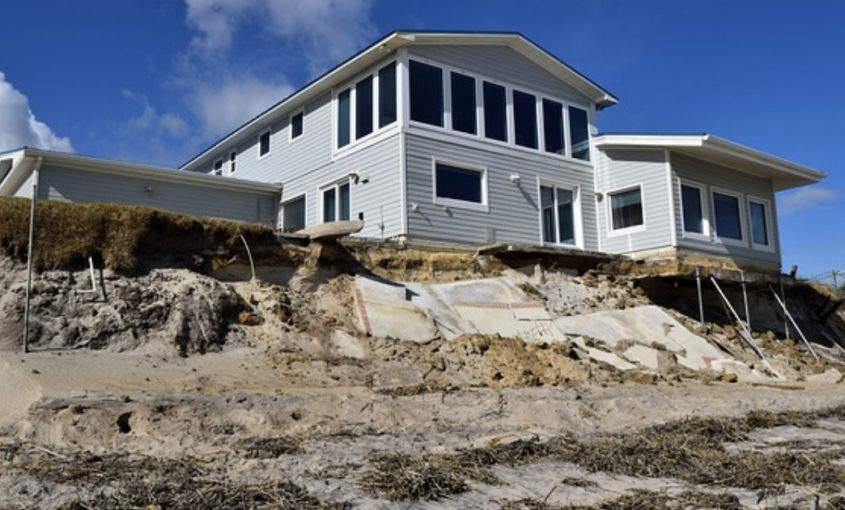Building a custom home in Florida, on or near the coast, requires serious consideration of the hurricane risk. While it is not possible to make a completely hurricane-proof home, there are many things to consider when constructing a new home with the ability to withstand severe weather.
One Home Still Standing
When the category 4 Hurricane Michael hit Mexico Beach, Florida in 2018, almost all the homes built near the beach were destroyed. Almost everything was blown down by the 155 mph winds or washed away by the storm surge. Only the foundations remained where most of the homes used to be, except for one remarkable three-story home.
ABC News reported that this newly-built home withstood the hurricane almost undamaged compared to the piles of rubble and debris that remained from what was left of the other homes. How can that be?
The home survived because it was designed specifically to withstand hurricane conditions at a level of severity never seen before. It was built 12 feet above the ground on columns and anchored 28 feet into the ground.
Florida Building Codes
In the past, the Florida Building Codes were updated in the aftermath of the damage caused by Hurricane Andrew. In Jacksonville, Orlando and other areas in St. Johns County the new building codes reflect the increased risks.
Hurricane damage comes from wind damage and water damage so the building codes need to address both of these risks. The best custom-home builders are offering upgraded homes that have safety standards, which far exceed the minimum requirements.
Wind Damage
High winds cause roofing to fly off. Winds also make virtually anything the wind can pick up into a projectile. This includes fence posts, street signs, tree limbs, and any debris small enough to be blown around. These projectiles hit the exterior surfaces, windows, and doors of a home with the force of a torpedo.
Big things can be pushed around also. When Hurricane Dorian hit the Bahamas in September 2019, some vehicles were lifted from their driveways, rolled over, and then they smashed into the walls of the homes.
Florida building codes for hurricanes are designated by risk zones, which are:
- Category I — Homes must withstand wind speeds of 156 mph up to 165 mph.
- Category II — Homes must withstand wind speeds of 170 mph up to 175 mph.
- Category III — Homes must withstand wind speeds of 180 mph up to 185 mph.
Hurricane Dorian reached wind speeds of up to 183 mph. This hurricane stayed in place over the Grand Bahamas Island for more than two days with winds at these high speeds. There is a high likelihood of experiencing an increasing number and severity of hurricanes due to climate change.
It is important to note that building codes are the minimum requirements. There is no reason why a custom home builder should be limited to meeting only the minimums. Many Floridians are learning that it pays to invest the 15% to 25% more in new construction costs to build a home in Florida that is more hurricane resistant. After all, which home do you want to own on the beach, one that was destroyed by a hurricane or the last one standing?
Water Damage
Water damage comes from rain that causes flooding and storm surge. Storm surge can be many feet high. Storm surge from hurricanes can reach 20 to 30 feet. This means that a hurricane-resistant home needs to be able to withstand being completely flooded.
Hurricane-Proof Homes
To protect from wind damage use shatter-proof glass for windows. Protect the windows, doors, and other openings by having strong steel shutters that can be shut when a hurricane is on the way. These steel shutters should be rated to withstand a projectile fired at them at up to 200 mph. The strongest shutters are made from the steel used for armored tanks. They will get dented on impact with a high-speed projectile but the projectile will not pass through.
Homes made from concrete and those with water barriers built into the walls do better when flooded. Designs that make the walls of a home more like the walls of a swimming pool can withstand exposure to water. Electrical wiring is protected within the wall by being encased in waterproof housings and tubing.
Go High and Watertight
Homes with three stories are nice to have. If a hurricane is coming, then all the items that can be easily damaged from flooding are moved from the lower floors to the top floor. This may help to keep them out of harm’s way until the storm passes.
In some places, due to height restrictions, it is not possible to have a three-story home on the beach since it will block another home’s view. In those cases, it is possible to use water containment techniques that are similar to the ways that water leaks are contained in a submarine.
Water-resistant areas of the home can be created, which can be sealed off from the rest of the home. These serve as storage areas in times when flooding is likely.
Summary
Building a new custom home with Envision creates the opportunity to consider hurricane-proofing that will make the home more resilient in the face of severe weather. It does not seem like weather problems are going to disappear any time soon. Wise homeowners and custom home builders construct new homes to standards that are even higher than the minimums required by the building codes.
Contact Envision Custom Homes to discuss your custom home project and get a consultation with the experts in Florida homes.

